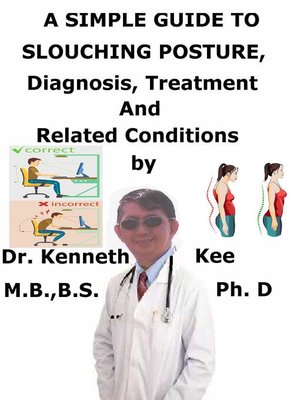A Simple Guide to Slouching Posture, Diagnosis, Treatment and Related Conditions
ebook
By Kenneth Kee

Sign up to save your library
With an OverDrive account, you can save your favorite libraries for at-a-glance information about availability. Find out more about OverDrive accounts.
Find this title in Libby, the library reading app by OverDrive.



Search for a digital library with this title
Title found at these libraries:
| Library Name | Distance |
|---|---|
| Loading... |
This book describes the Slouching Posture, Diagnosis and Treatment and Related Diseases
This book took me a longer time to complete because I was trying out all the methods to improve the posture. All treatment methods are found to help! Kenneth Kee
Generally people sit hunched, arms crossed in a judgmental way, the whole of the bodies pulled into a frown - Jeremy Hardy
The slouch (also called iHunch) is a term used to indicate a person when they sharply bend their neck over their tablet or phone.
This action pushes the head forward in an unnatural position and places a lot of pressure on the spine.
A slouching posture can cause a number of medical disorders throughout the body such as back and neck pain, difficulty breathing, poor digestion, nerve issues and more.
A slouching posture places stress on the joints and tissues, producing joint stiffness, weakened muscles, and inflammation.
For many people, this disorder does not appear that serious.
The moment the person starts to feel the neck pain, back pain, headaches, and major shoulder pain, the person will begin to understand how serious this disorder is.
A slouching posture on the other hand is the form of posture that happens from certain muscles tightening up or shortening while others lengthen and become weak.
When a person considers posture, that person considers models that have to train to walk with good posture by learning to walk confidently with a book placed on their head.
A slouching posture can have an intense effect on the risk of producing lower back pain, headaches and other linked discomforts.
A slouching posture can also induce physical pain and emotional distress.
The slouching posture (also called "texting neck") has become an epidemic with everyone always bent down to look at their phones or tablets.
People spend on average more than 3.75 hours daily bent over their phones.
The more people slouch, the greater is the weight that people place onto the spine.
This can produce permanent spine curvature, back pain, neck pain, and headaches.
Causes are:
Fatigue
Foot Placement
Shoulder Slump
Arched Lower Back
Locked Knees
Risk factors that can affect the slouching posture are:
Prolonged Sitting
Occupation
Sporting Activities
General Fitness
Symptoms:
The most frequent symptoms of the slouch are:
Potbelly
Pain anywhere on the body
Muscle fatigue
Rounded shoulders
Bent knees when walking or standing
Headaches
Back pain
The head leans backward or forward
Hunching can damage the lungs by lowering lung capacity by up to a third of its regular capability.
Oxygenated blood insufficiency can lead to blood and vascular disease and shortness of breath.
Heartburn and Poor Digestion is affected by hunching since it makes it more difficult for food to pass through the intestines efficiently.
Poor slouching posture induces constipation and stress incontinence
Poor slouching posture results in problems with the body's fibers, nervous system and muscles
Slouching is not good for the self-esteem
The first rule of treatment of the Slouch is to be aware of any slouching and prevent the formation of a Slouch
The correction of bad slouching posture takes the pressure off the joints by performing posture-strengthening exercises and practicing good posture:
Stand Upright
Walk Like There is a Book on The Head
Sit upright
Change position
Avoid backpacks
Do not slouch to Text or Using the computer
Select a Proper Mattress
Do Yoga...







